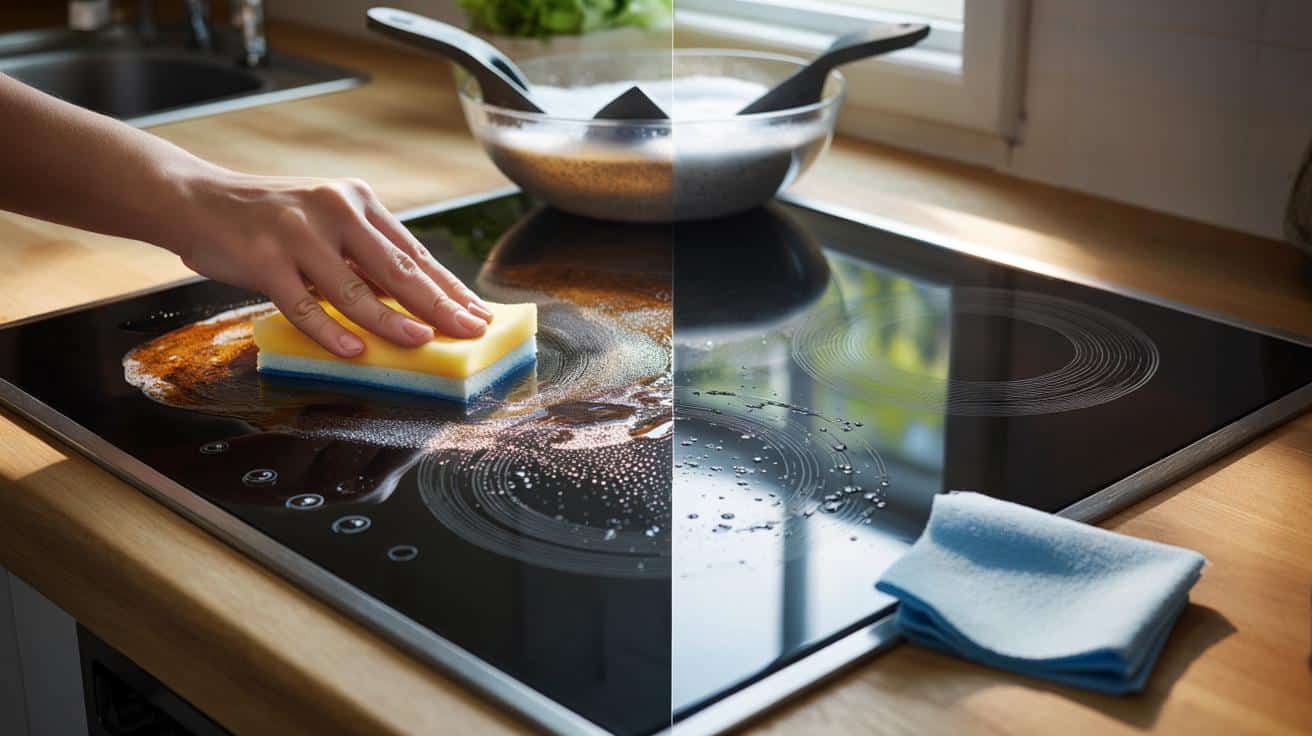A quiet, low-cost shortcut is spreading, kind to glass yet ruthless on baked-on spills.
You want a fast reset before dinner, not a chemistry set and a half-hour scrub. This simple routine avoids vinegar and bicarb, works on gas, ceramic and induction, and leaves no sour smell hanging in the kitchen.
Why skip vinegar and bicarb this time
Vinegar can streak shiny glass and leave a lingering odour. Bicarb turns gritty when under-dissolved and risks micro-scratches on ceramic. Many hobs also include aluminium trim or coated parts that dislike strong acids or dusty abrasives.
There’s a softer route that still cuts through fat. It uses two things you already own and it behaves predictably on mixed materials.
Forget harsh fizz and fumes. A pre-wet mild abrasive and a surfactant do the heavy lifting in minutes, not elbow grease.
The 10-minute, scratch-free method
What you need
- 1 tablespoon fine table salt (not coarse; it dissolves faster)
- 1 tablespoon washing-up liquid (neutral pH, unscented if you prefer)
- 2–3 tablespoons warm water
- 1 soft microfibre cloth and a non-abrasive sponge
- Plastic scraper (optional, for caramelised spots on glass)
Step-by-step
Keep every salt grain wet on glass. Friction scratches; lubrication protects. If in doubt, add a little more water.
Why it works
Washing-up liquid breaks the surface tension of fatty films, so residues release quickly. Fine salt adds controlled bite without scouring when kept wet. Warm water lowers grease viscosity and helps the gel spread into corners. The result is a quick lift rather than a drawn-out scrub.
Tailor it to your hob
Gas and enamel
Use the gel at full strength around burners. Work with a nylon brush near seams. Keep water away from ignition points and dry parts fully before relighting. Avoid soaking aluminium burner rings for long periods.
Induction and ceramic glass
Pre-wet generously and apply a very thin layer. For caramelised sugar or milk, hold a plastic scraper at a low angle and shave gently while the gel lubricates. Rinse twice to prevent haze.
Stainless steel
Wipe along the grain. Rinse well to avoid salt marks. Finish with a microfibre buff for a uniform sheen.
| Surface | Gel dwell time | Notes |
|---|---|---|
| Gas enamel | 5–7 min | Brush around burner wells; dry parts fully |
| Ceramic/induction | 3–5 min | Keep salt fully wet; use plastic scraper for sugar |
| Stainless steel | 4–6 min | Follow the grain; rinse generously |
If the mess is severe
The steam sandwich
Lay a hot, damp microfibre over the cold hob for three minutes, then lift and apply the gel. Steam softens carbon so the gel finishes the job. This helps when sauce burned onto glass.
Black soap pass
Spread a teaspoon of black soap in a thin film over stubborn rings. Wait eight minutes. Wipe, then do a quick gel pass to clear haze. Black soap punches above its weight on oxidised grease.
Shaving foam spot fix
For small scorch marks on ceramic, a blob of white shaving foam left for five minutes loosens residues. Wipe and rinse. Avoid coloured gels that can stain pale trims.
Repeat short, gentle passes instead of one forceful scrub. Time and lubrication reduce risk far more than pressure does.
Safety and small print
- Work on a cooled surface and keep the room ventilated.
- Gloves help if your skin reacts to detergents.
- Do not use dry salt on glass. Always keep it wet.
- Never mix bleach with any cleaner. Rinse away residues before swapping products.
- Keep water out of electrical controls and gas igniters.
- Patch-test trims and decals on an inconspicuous spot.
Make it last longer
After cooking, a 30-second wipe with a damp microfibre and one drop of washing-up liquid stops films setting hard. Once a week, remove gas trivets and caps for a quick soak. On ceramic and induction, a pea-sized measure of hob protector cream every fortnight helps stains release faster.
Avoid spraying oil directly over a hot surface. Decant oil near the worktop instead. Fit splatter guards when frying and keep pans centred to limit boil-overs that carbonise.
What it costs and how it compares
A single clean uses roughly 17 g of fine salt (about 2p) and 10 ml of washing-up liquid (about 4–6p), plus tap water. The total sits near 6–8p per session. Branded hob gels often land at 30–40p per clean when you price the dose.
Ten minutes, under 10p, and no harsh fumes: a routine you can actually keep after a long day.
Useful extras for specific spills
- Burnt sugar or syrups: soften with the steam sandwich, then scrape with a plastic blade under the gel.
- Melted cheese: chill the patch with an ice cube for 30 seconds, flick off the firmed edge, then gel-wipe.
- Tomato stains on glass: a second, quick gel pass clears the faint red tint without extra pressure.
If you cook daily, set a micro-routine
Time it once. You’ll likely spend two minutes after breakfast and three after dinner if you wipe while the hob is lukewarm. Schedule a six-minute Friday reset for grates and knobs. Small, regular doses of care beat monthly overhauls that invite scratches.
For renters, photograph the hob after each deep clean. You build a record that shows you kept surfaces in good shape, which helps with deposit checks. Homeowners can note which products touch aluminium or rubber parts to avoid long-term dulling.









Just did this on my induction hob after a syrup spill—salt gel + plastic scraper—took 6 mins, zero streaks. Why did I ever scrub like a maniac? Thanks!
Salt on stainless makes me nervy. Even “fine” can leave hairline marks if it dries. Are you 100% sure it’s scratch-free on brushed steel, or should I skip salt there altogether?